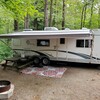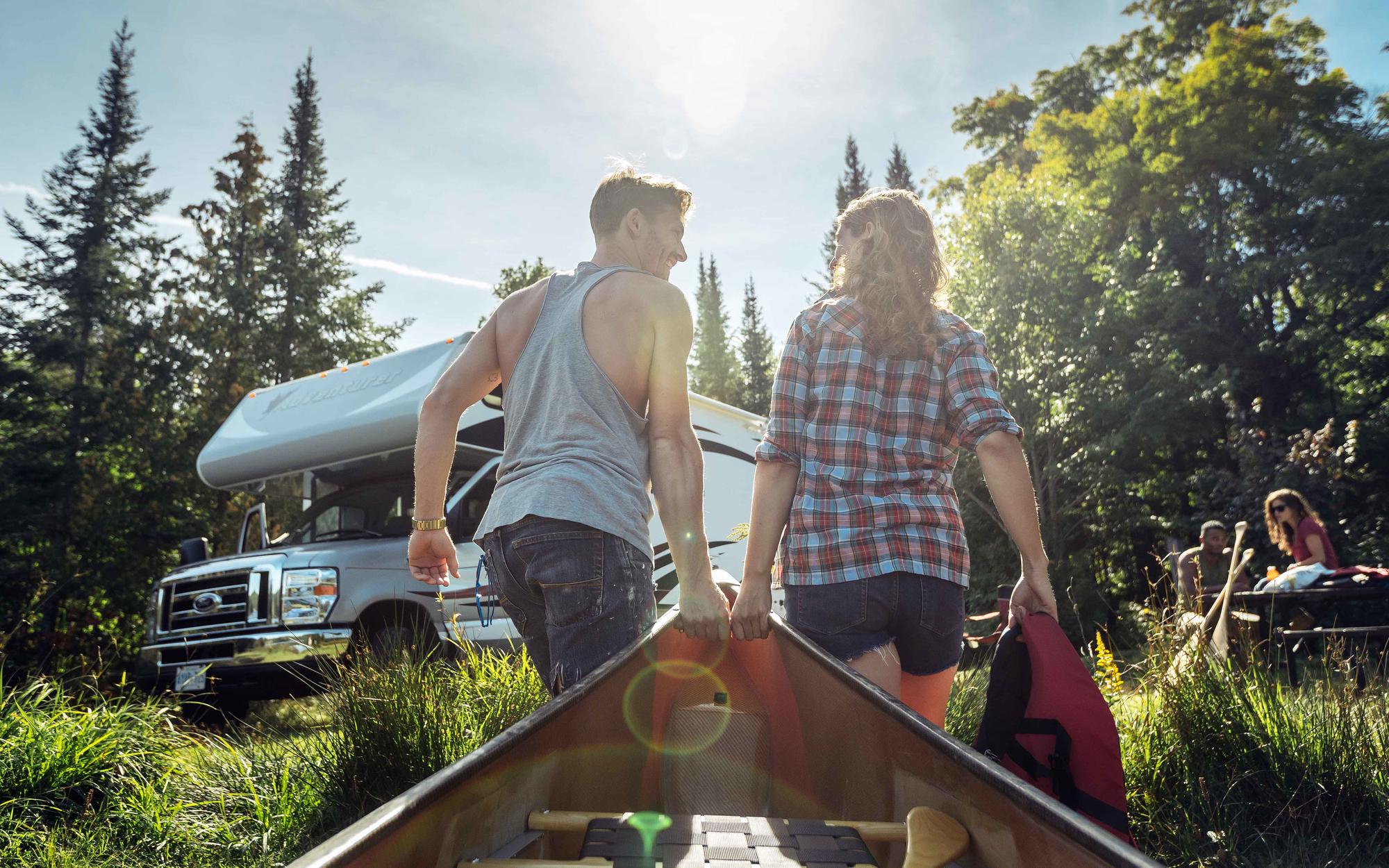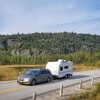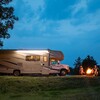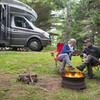
RVing With Cats: How Frida Showed Us That Home is Where the Cat is
The idea wasn’t to get a cat to live in the Airstream with us. The idea was actually not to do that.
In fact, when I had suggested getting a cat, Hillary had said “no,” definitively. And it made sense. “Think about having a litter box in here,” she’d said, and it was hard to argue with. That wasn’t exactly what I had wanted either. The trailer is 22ft long, and on a cold or rainy day often feels too small for the two of us.
Still, it must have been on my mind, because one summer evening a year after I'd first suggested it, I said, “what if one night in the middle of the night, the cutest kitten you’ve ever seen comes out of the corn field and needs a home…that happens sometimes in the country, right? Could we keep it?” We were living in the trailer on a friend’s farm in Aylmer, Ontario, at the time.
Not even two weeks later, we were getting ready for bed in the RV and I stepped outside for a moment to look at the stars. I heard a squeaking noise, then heard it again. Then Hillary heard it, too. And that was Frida: less than 5 weeks old, appearing out of the dilapidated falling-down barn, far from any homes or any litters of kittens we knew of, all on her own.
In many ways the rest is history, and yes, I do say I manifested our cat. Since then, Frida’s been a part of the family, spending the first 6 months of her life as a full-time RV-farm cat, then transitioning with us into our current home when we moved. And while we live in a house now most of the year, she still comes with us on many a road trip throughout Ontario.
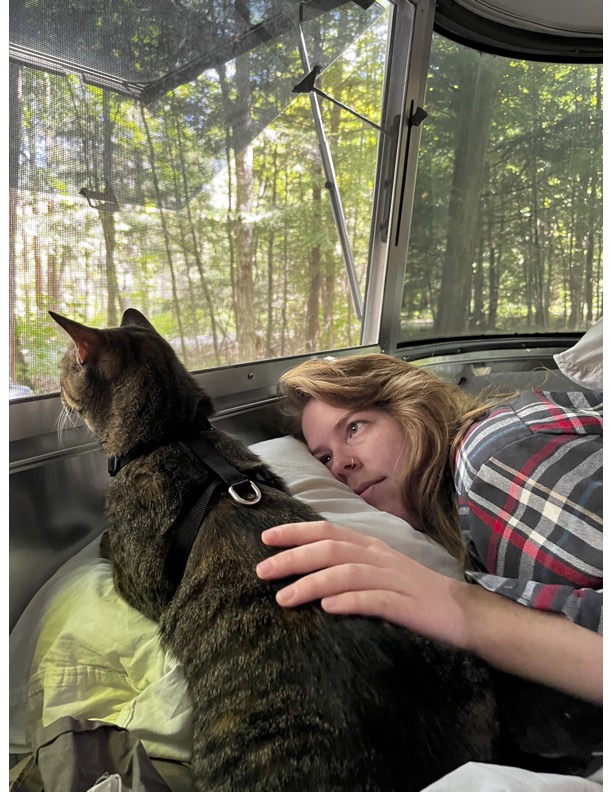
Here are some of the things we’ve learned travelling with Frida over the last 2 years:
Start ‘em Driving Young
We started Frida in the truck on her second day with us. We knew that if she was to stay with us, we would need to get her comfortable with being on the road. At that time, we hadn’t stayed in the same place for more than 3 months in over a year, and the idea of a cat joining us only seemed feasible if she too was comfortable with a mobile life.
That first summer, we took her driving almost every day. She'd come to the grocery store and to dump the blackwater, all in an effort to acclimatize her to a life of movement and unpredictability. We became her constants, and as a result formed an incredibly close bond.
Today, once we’re out of the city, we’ll let Frida out of her carrier and hold her on our lap, or let her lie draped around one of our necks, resting between our shoulders and the headrest of the chair. I know not being in a carrier isn’t recommended, but for longer trips she is certainly happier, quieter, and clearly a fan of the view and changing landscape– observing through the window, eyes flitting between objects.
Letting her out of the carrier also allows Frida to take her own bathroom breaks while we drive, which is convenient, but also occasionally leaves us plugging our noses and cracking the windows.
Do the Litter Every Day
Just like Hillary feared, it turns out having a litter box in a trailer really does smell. Do it everyday. Do it without fail. And change your litter completely more frequently than you would in a house or apartment. It makes a difference.
We avoid scented litter, and try to find brands that are dust free and don’t spread or track as easily. Still, regular sweeping is necessary to keep the floors clean. We keep the box itself right by the trailer door or in the shower with the door propped open (when the shower’s not in use). This makes for easier cleanup, as well as keeping the litter box out of our sitelines. Even so, trust me that by the end of a short road trip you’ll have your cat’s bathroom routine memorized… but if you’ve RVed with family or friends before, you’ll know already that that’s just part of living with others in a small space.
Adjust Your Plans to Your Cat
The thing about committing to bringing a cat RVing is that it requires a good amount of adjustment to the activities you might otherwise partake in. Yes, I imagine travelling with a dog requires adjustments too, but at least with a dog you can still maintain a reasonable pace while out on the trail or checking out a farmers market. With cats, unless you’ve leash-trained yours incredibly well, expect to dramatically slow down when out and about, as well as reduce the duration of activities. You’ll also need to be conscious of over-stimulation, as crowds and noise can be overwhelming and traumatic for a cat if they aren’t used to that.
These adjustments can impact all aspects of a trip. I’m not a fan of leaving Frida alone in the trailer for multiple hours at a time, especially in unfamiliar locations, which is basically anytime we’re on a trip (as opposed to the farm where we store the trailer through the summer). This is in part because I worry about her being so cute and irresistible that she might get catnapped, and in part because the windows need to be open to keep her cool enough. She has this habit of climbing up the screens with her claws to swat at flies, which leads me to worry about her escaping. This inability to leave Frida for too long impacts scheduling, and has led Hillary and me to adopt a more consistent schedule when bringing Frida on road trips.
Find Your Routine
Just like travelling with kids, cats (and dogs from what I’ve heard), do better with routine. Animals are often fairly regimented in their natural behaviour, so creating some consistency and structure to how you operate when on the road can go a long way in creating a comfortable travel experience for your feline friend.
The more we’re able to stick to her regular meal routine, the better, and when we’re able to manage driving and hiking around her oscillating manic mode and passed-out mode, that’s the best. Dawn and dusk are when cats are most active, and afternoons and overnight are when they sleep most. Factoring that into your planning can go a long way in maintaining a good synergetic relationship between you, your cat, and your activities.
Last summer, my partner and I did a road trip east from London, ON, as far as Isle de Plaisance on the Ottawa river. We got in the habit of going out and exploring in the mornings with Frida tucked in the backpack, then stowing and doing our driving in the afternoon. Frida would find a spot to curl up in the cab or on one of our laps and sleep through much of the drive.
Harness Train Regularly, Even Through the Off-Season
Frida is not much of a harness cat, and this is an inhibitor for us and an area that we are working on improving. I have a sister in Vancouver who takes her cat to the beach almost everyday, where they go on long walks and even paddleboarding together.
But for Hillary and me, putting Frida in a harness and on a leash is a sure-fire way to get wrapped around a telephone pole or pulled under a bush.
Right now, when we’re hiking or checking out towns, we’re limited to bringing Frida with us in her travel backpack, only letting her out when we’re stopping for snacks or a break. In there, she’s quite chatty, and we find likes it better when riding in front (chest-pack position) than on either of our backs. When we do let her roam on an extended leash, it goes better when we are in quiet places with less stimulation. Anywhere where dogs, crowds, or young kids are present is not ideal.
Not being leash trained is definitely a hindrance, and limits Frida’s activities too. If I could go back in time to Frida’s kitten years, this is the one thing I’d do differently, and start right away. From speaking to my sister about how she trained Shuri to be on a leash (and hang out with dogs) so readily, the keys are the same as driving... start them early, and be consistent, even in the off-season.
Heat, Predators, and Paparazzis
Some final considerations to keep in mind are weather, particularly heat, risk of predators, and people reacting to the phenomenon of having your cat out on a hiking trail with you. Here are a few things to keep in mind that will help everyone have a good time:
- Always bring water and a water dish and keep an eye on your cat’s behaviour when out and about–– panting, rapid breathing, and unusual behavior or noises can all be signs of being overheated.
- Watch out for rattlesnakes. It’s not just large predators like coyotes that can be dangerous to cats, but also small venomous or poisenous creatures. A rattlesnake’s size may make it a source of curiosity for a cat, but its venom would kill a cat rather quickly.
- Because instagram has made having an “adventure cat” a phenomenon, be prepared for some extra attention out on the trail or around the campfire. Dogs are an everyday occurrence, but a cat that camps is a much rarer breed. Frida is certainly a conversation starter for us, and a quick way to form connections with children and the elderly alike. But from her perspective, all the attention can be overwhelming.
Despite the additional considerations, when we plan accordingly, the extra tasks it takes to have Frida along for the ride seem less like annoyances and more like routine parts of road life, the same as hitching and unhitching and remembering to stow properly before hitting the highway. And is it worth it to have my best furry friend along as a road trip buddy? In my opinion, absolutely.
Recommended Articles

The Complete 2026 List of RV Shows in Ontario

RV Camping Sites in Ontario: The Ultimate Guide

An RV Camping Guide to Ontario's Provincial Parks

4 Essential RV Itineraries From Toronto

5 Tips on How to Go Full Time Remote Work With Your RV

RV Summer School: An Educational Road Trip That Kids Will Actually Enjoy

A Guide to RV Camping at Pancake Bay Provincial Park

Love on the Run

Have Your Toured Ontario's Provincial Park Nature Trail?

An RVer's Guide to the Voyageur Trail

Camping and RVing in Restoule Provincial Park
